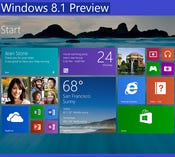Microsoft Releases Windows 8.1 Enterprise PreviewMicrosoft Releases Windows 8.1 Enterprise Preview
Microsoft's Windows 8.1 Enterprise Preview includes a lot to make businesses happy. But even if it succeeds, the future of Windows 8's Modern UI could still be in doubt.


10 Hidden Benefits of Windows 8.1
10 Hidden Benefits of Windows 8.1 (click image for larger view)
Microsoft on Tuesday released Windows 8.1 Enterprise Preview.
Windows 8 adoption has been sluggish, among both consumers and enterprises. The preview version of standard Windows 8.1 was released in June and includes several refinements with which Microsoft hopes to assuage Win 8 critics. These include a boot-to-desktop mode and a restored Start button, both of which are important in enterprise environments, where traditional PCs are still used more than tablets.
The Enterprise Preview includes a number of business-oriented features that aren't present in the standard Windows 8.1 preview. In a blog post, Microsoft highlighted seven "premium" features that differentiate the enterprise-oriented preview of Windows 8.1.
[ Find out how Microsoft is pursuing the enterprise cloud-market crown. See Windows Server 2012 R2 Widens Enterprise Cloud Gateway. ]
The Windows To Go Creator enables IT to create a manageable corporate Windows 8.1 desktop on a bootable external USB drive. Microsoft is pitching the feature as a potential BYOD-enabler that allows employees to securely access corporate data on personal machines.
Start Screen Control allows administrators to define how corporate-issued devices display the Live Tile layout on the Start screen.
DirectAccess allows users to remotely access documents on the corporate network without a separate VPN. It also enables admins to deploy policy and software updates.
BranchCache is aimed at employees in branch offices. By locally caching files, websites and other content from central servers on hosted cache servers or PCs, it eliminates the need to repeatedly re-download content across a WAN environment
Due to improvements in Windows Server 2012 and Microsoft's RemoteFX, the Windows 8.1 Enterprise Preview also includes VDI enhancements that include better support for 3-D graphics and use of USB peripherals and touchscreens across any type of network.
AppLocker is intended to increase enterprise security by empowering IT to define which files and apps a user or group is allowed to run on a PC.
Finally, Windows Enterprise Side-Loading permits internal Windows apps to be side-loaded on domain-joined devices running Windows 8.1 Enterprise.
The blog post also noted that the Windows 8.1 Enterprise Preview contains several business-aimed features previously revealed at Microsoft's TechEd Conference in June.
These include Assigned Access, which limits how corporate users experience the Windows Store; expanded support for third-party VPNs; Open Mobile Alliance Device Management capabilities, which allow MDM products from vendors such as MobileIron and AirWatch to be used without an additional agent; and additional capabilities that allow IT managers to control how sensitive data is accessed and to remotely wipe a device of corporate material without affecting an employee's personal content.
When Microsoft released the standard Windows 8.1 preview, Gartner analyst Carolina Milanesi told information that the update is a definite improvement over its underperforming predecessor. Microsoft has "done everything they needed to, in terms of making the OS more engaging, and linking the familiar of the desktop with the Modern UI," Milanesi said at the time.
Indeed, many analysts expect Windows 8.1 devices to sell better than current Win8 devices have. In addition to the OS update, cheaper, more compelling hardware and a growing, though still incomplete, app library are expected to lead the charge.
For businesses, meanwhile, Windows 8.1 addresses a different concern: Preserving goodwill among all the users who'd be happy to just keep using Windows 7, or even Windows XP.
The reinstated Start button and boot-to-desktop option could appease some of these disillusioned users, and many IT admins will value the extra tools and functions that are now on display in the Enterprise Preview. Still, Windows 8.1's enterprise prospects are uncertain.
For one thing, around 150 million business users still rely on Windows XP, which is scheduled to lose support in less than a year. For Microsoft, getting all of these customers to update in time could be a challenge. And even if the company succeeds, most businesses are turning to Windows 7, potentially leaving Win8's Modern UI without a strong business foothold.
Moreover, even if businesses upgrade to Windows 8.1, the future of the Modern UI could still be in doubt. For certain tasks, Windows 8 currently forces users to jump between the Modern UI and the desktop. Microsoft has promised, however, that the update will allow users to operate solely within the desktop or the Modern UI, without any reliance on the other interface. With the boot-to-desktop option added to the mix, this means users can essentially seal off the Live Tiles, turning Windows 8.1 into an updated version of Windows 7 -- albeit one whose Start button doesn't lead to a Start Menu.
Microsoft CEO Steve Ballmer's goals demand that the Modern UI become more popular, so the company is no doubt cognizant of the chance that Live Tiles could languish even if enterprises start adopting Windows 8.1. Windows software will remain a fixture in the enterprise for years to come -- but if most of that software is of the "legacy" variety, Microsoft will face serious trouble.
Then again, if Windows 8.1 helps the company attract increased developer enthusiasm, the Windows Store could soon feature not only an exciting variety of consumer apps, but also more line-of-business and productivity titles, which could entice more businesses to give the Live Tiles a chance.
About the Author
You May Also Like






